- Tentacles and arms
- Short stubs remain of the tentacles and appear to be sealed over at the ends (photograph) indicating that the loss of tentacles was associated with maturity and not trawl damage during capture.
- All arms damaged at tips; appear to be subequal.
- Tentacle base more slender than arm base (width ca. 75% of arm base).
- Buccal connectives attach to ventral margins of arms IV.
- Suckers The arm suckers appear to have smooth rings under the light microscope.
- Head and funnel
- Eyes small, apparently normal construction. Eye opening missing due to damage.
- Funnel locking-apparatus with large oval depression.
- Beaks were not examined.
- Fins
- Anterior and posterior lobes present; each fin approximately circular in outline.
- Viscera
- Anal valves apparently absent.
- Ink sac apparently absent.
- Oviducal glands very large (4 mm); nidamental glands normal size (each 7 mm x 3 mm). The nidamental glands were removed by a previous investigator and placed in a vial with the ovary
- Photophores
- Photophores absent.
- Gladius
- Short, slender free anterior rhachis.
- Long, slender posterior region.
- Complex structure in posterior third somewhat like a conus (arrow in bottom photograph).
- Pigmentation
- In preservation, visceral sac with dark purple-brown pigmentation and some light purple pigmentation on surface of squid but pattern cannot be determined; no obvious chromatophore organs present.
- Measurements and counts
- Mantle length - 16 mm (label on jar indicates 42 mm ML)
- Gladius length - 25 mm
- Head length - 3.5 mm
- Eye diameter - 1.8 mm
- Buccal mass length - 6.5 mm
- Buccal mass width - 3.5 mm
- Tentacle thickness - 2.3 mm
- Width of arms III and IV near base - 3.0 mm
- Arm IV ( left) - 10 mm +; 43+ sucker count.
- Fin length - 7 mm
- Fin width - 14 mm

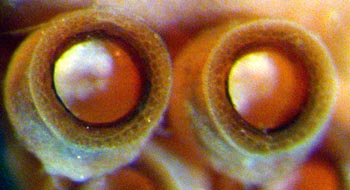
Figure. Oral view of two large arm IV suckers from Promachoteuthis sp. D.
Scanning electron micrographs of the suckers can be seen here.
Comments
Apparently the mantle has shrunk to about 38% of its original length during fixation and preservation. The present gladius length is considerably smaller than the unfixed mantle length. Since shrinkage of the gladius is unlikely, we assume that the gladius did not extend the full length of the mantle.
The peculiar conus-like structure in the gladius is somewhat similar to a structure in the gladius of P. megaptera. The gladius of Promachoteuthis sp. D had been removed by a previous investigator and placed between two glass slides. We attempted to remove it from the slides to get a better view of the "conus" but we were unsuccessful due to the delicate nature of the gladius.
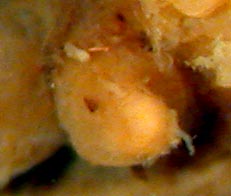
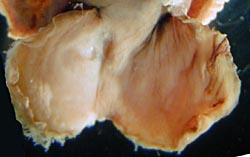
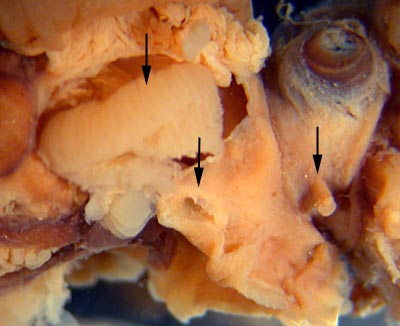

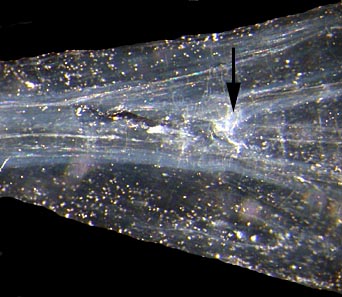




 Go to quick links
Go to quick search
Go to navigation for this section of the ToL site
Go to detailed links for the ToL site
Go to quick links
Go to quick search
Go to navigation for this section of the ToL site
Go to detailed links for the ToL site